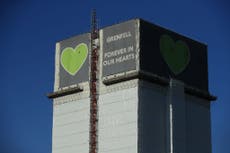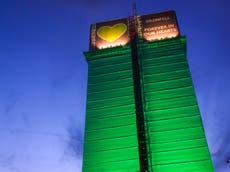Safety test on cladding system containing same component as Grenfell mistakenly halved flame growth speed due to ‘typo’
Test chief supervisor only became aware of error during course of inquiry last year
Your support helps us to tell the story
From reproductive rights to climate change to Big Tech, The Independent is on the ground when the story is developing. Whether it's investigating the financials of Elon Musk's pro-Trump PAC or producing our latest documentary, 'The A Word', which shines a light on the American women fighting for reproductive rights, we know how important it is to parse out the facts from the messaging.
At such a critical moment in US history, we need reporters on the ground. Your donation allows us to keep sending journalists to speak to both sides of the story.
The Independent is trusted by Americans across the entire political spectrum. And unlike many other quality news outlets, we choose not to lock Americans out of our reporting and analysis with paywalls. We believe quality journalism should be available to everyone, paid for by those who can afford it.
Your support makes all the difference.A safety test on a cladding system containing a component also used in Grenfell Tower had mistakenly halved the time flames would take to rise up a building, due to a typo in a report made in 2005, an inquiry has heard.
The “typographical error” meant a document issued by the Building Research Establishment (BRE) stated it took 10 minutes for flames to climb four metres up Kingspan’s Kootherm K15 product, but it actually only took five minutes.
The product was one of the types of insulation used in the tower’s cladding system.
Philip Clark, BRE's former cladding test chief supervisor and author of the 2005 report told the hearing on Wednesday that the error "should have been corrected".
He added he only became aware of the mistake during the course of the inquiry last year.
The inquiry saw the original handwritten notes from the test day in 2005 showed the flames reached the four metre mark five minutes after ignition, which was initially correctly recorded.
But the official report said flames took 10 minutes to climb four metres after data was taken from the wrong column in the notes.
This error was then repeated through all of the test data from that point forward.
"What appears to have happened is the first couple (...) were correct and then the 10 has been transposed across," Mr Clark said.
He described it as "a typographical error which has then been perpetuated through the rest of the report and hasn't been picked up".
Mr Clark said he did not notice the error until 15 years later during inquiry hearings last year.
The tests were carried out in May 2005, but the report was not published until 8 December of that year following an email from Mr Clark's boss days earlier suggesting he was getting his "arse kicked" over the delay.
Mr Clark admitted he was "heavily loaded with lots of other jobs" when the report was written and "was taking on more than I should have been really and it was impacting some of the delivery times for stuff".
Inquiry lawyer Richard Millett QC put to him that the report was put together "over a matter of days" after a "boot up the backside" from his boss.
Asked if this is what happened, Mr Clark said: "Even if it was it went through the due diligence process anyway, regardless of whether it was done in three months or two days it still went through the same due process and was checked by others, so again other people had sight of it and had they had any questions they would have pushed them back to me to get rectified."
The inquiry has previously heard that Kingspan sold K15 with an unrepresentative fire certificate based on a 2005 test which claimed it was safe for use on buildings higher than 18 metres.
The majority of the insulation used on the west London tower block was made by Kingspan's rival firm Celotex.
The inquiry is examining how Grenfell Tower came to be coated in flammable materials which contributed to the spread of flames which shot up the tower in June 2017, killing 72 people.
This article was updated on 4 March, 2021, to distinguish between the testing of cladding component materials, and the testing of cladding systems which contain those components.
Additional reporting by Press Association




Join our commenting forum
Join thought-provoking conversations, follow other Independent readers and see their replies
Comments